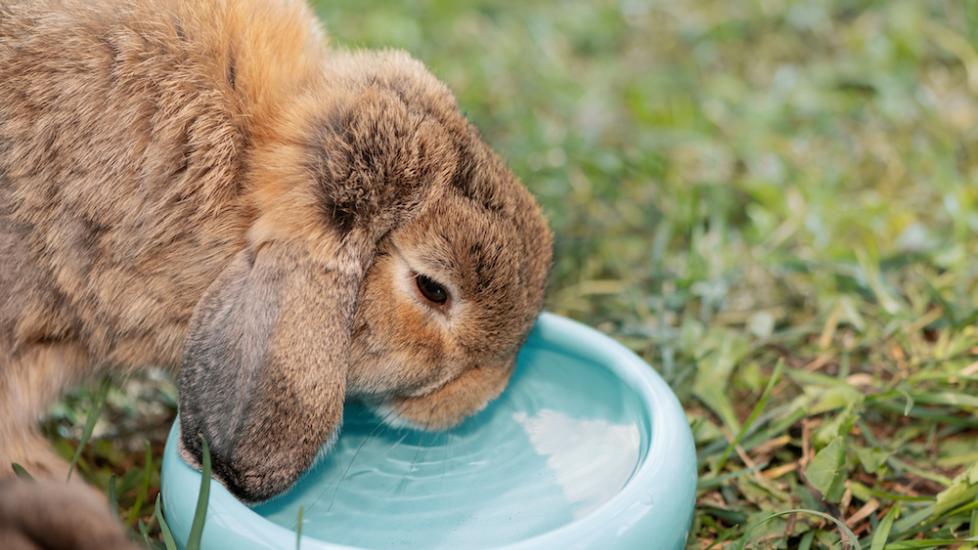E. cuniculi in Rabbits
What Is E. Cuniculi in Rabbits?
Encephalitozoon cuniculi, or E. cuniculi, is a parasitic infection that affects rabbits and, less commonly, dogs, cats, pigs, humans, rodents, horses, and other mammals. This parasite most commonly affects the neurologic system, the kidneys, and the eyes of a rabbit.
E. cuniculi is an intracellular parasite, which means it must invade the host’s cells to replicate. Once replicating, it causes the cells to burst, spreading the infection to nearby cells and leading to inflammation throughout the body. This inflammation is known as encephalitis (in the brain), nephritis (in the kidney), or uveitis (in the eye).
E. cuniculi is common in rabbits, but many rabbits are asymptomatic their entire lives (meaning they show no symptoms) while the parasite lies dormant. Often, when a rabbit’s immune system is already compromised (such as with
E. cuniculi is also zoonotic, meaning it can spread from rabbits to humans. Pet parents must be cautious when interacting with and cleaning up after their pets to decrease the chances of infecting themselves. Always consult with a human healthcare provider with any concerns about a zoonotic disease.
Recommended Products
Symptoms of E. Cuniculi in Rabbits
Most rabbits never show signs of E. cuniculi. However, when they do, E. cuniculi most often shows as a problem in the central nervous system secondary to inflammation in the brain. The parasites invade the cells in the brain, and the resulting inflammation may cause:
-
Head tilt
-
Abnormal eye movements
-
Discoordination
-
Circling
-
Rolling
-
Seizures
When E. cuniculi affects the kidneys, clinical signs include decreased appetite, changes in water consumption, and lethargy.
E. cuniculi in the eye manifests as cataracts or white areas inside the eye, usually only on one side, but can occur in both. These symptoms are typically more common in younger rabbits.
Rabbits are sensitive animals. Some signs of E. cuniculi in a rabbit may be a medical emergency, depending on the case. It’s a medical emergency if a rabbit isn’t eating for over 12 hours, is experiencing seizures, or is lethargic. Pet parents should seek immediate veterinary attention for any of these symptoms.
Causes of E. Cuniculi in Rabbits
E. cuniculi is easily transmitted from rabbit to rabbit or other mammals.
The parasite's infective stage is called a spore, which rabbits shed in their urine. Other animals accidentally ingest this spore when exposed to food or water contaminated by the infectious urine. The spores travel to the rabbit’s intestinal tract, where they gain access to the bloodstream and travel to the target organs (typically the brain, kidneys, or eyes but can spread to the liver, lungs, or heart). Once ingested, it takes around one month before the infected rabbit begins shedding spores in their urine, continuing the cycle.
E. cuniculi can also spread to unborn kits through the placenta, often leading to ocular signs of E. cuniculi.
Because rabbits are social creatures, they often live with other rabbits. Infective spores in the urine are easily spread to housemates, leading to infection of the entire group.
Risk Factors for E. Cuniculi in Rabbits
Stress is a significant risk factor for rabbits developing clinical signs from E. cuniculi, in addition to having other diseases or illnesses. E. cuniculi tends to cause disease when the rabbit is most susceptible due to illness or other underlying conditions. Young and old rabbits are also more susceptible.
Keeping the cage and environment clean is very important to remove any potential spores from the cage. Dirty living situations will also cause more stress and make it more likely for a rabbit to shed spores or succumb to the disease.
How Veterinarians Diagnose E. Cuniculi in Rabbits
It is, unfortunately, difficult to diagnose E. cuniculi in sick rabbits. Blood tests can determine whether a rabbit has been exposed to E. cuniculi, but a positive result does not necessarily indicate an active infection.
Veterinarians often use paired blood tests, measuring
PCR testing of urine is helpful to determine if a rabbit is actively shedding spores. However, a negative test does not mean the rabbit does not have E. cuniculi—it only means it is not actively spreading the parasite. Rabbits will intermittently spread spores in their urine throughout their lives, with or without clinical signs.
Routine blood work (chemistry and complete blood count), skull radiographs, and cultures of any ear discharge are helpful tests to determine any accompanying diseases and aid in the overall treatment of a rabbit with E. cuniculi.
Biopsy and PCR testing of organ tissues is the only way for a definitive diagnosis. Unfortunately, this is typically only performed after an infected rabbit has passed away.
Treatment of E. Cuniculi in Rabbits
Treatment goals are to stop the spread of the parasite and the progression of clinical signs. Total elimination of the parasite may not occur, as it can remain hidden within the body's cells. Veterinarians typically prescribe a 30-to-60-day course of a deworming medication called
Studies show that this stops additional shedding of E. cuniculi, but inflammation within the body tissues remains, since the damage is already done. Because the inflammation is not eliminated, some clinical signs may not resolve completely and can recur in the future. Less common deworming treatments include albendazole, thiabendazole, and oxibendazole.
Veterinarians may prescribe antibiotics to treat accompanying ear infections contributing to signs such as head tilt, eye twitching, and rolling. Veterinarians must always use caution when picking an appropriate antibiotic, as rabbits can only tolerate certain types.
Recovery and Management of E. Cuniculi in Rabbits
Mild cases of E. cuniculi may resolve independently due to the rabbit’s immune system. However, pet parents should always bring their rabbit to a veterinarian to determine if treatment is necessary.
Severe cases often require hospitalization at a 24-hour center to provide supportive care, including IV fluids and frequent feedings. Rabbits experiencing seizures are treated with anti-seizure medications and additional support as needed.
Diet and nutritional support are also crucial during the recovery process. In general, the prognosis is worse as clinical signs worsen. Rabbits that continue to eat on their own tend to do best, but once they stop eating and require nutritional support, getting them back to normal can be difficult. Once rabbits receive treatment, clinical signs should not progress but may not return to normal.
Prevention of E. Cuniculi in Rabbits
Preventing E. cuniculi in rabbits can be tricky since many have hidden infections. Ideally, only bring rabbits into the house who have had their blood tested and are negative for E. cuniculi. Guinea pigs can also harbor and spread the disease, so caution should be used when homing together. Keep cages clean, as good hygiene can decrease the spread of E. cuniculi.
E. cuniculi in Rabbits FAQs
Can a rabbit survive E. cuniculi?
Yes, with treatment, rabbits can survive and live normal lives. Many rabbits live with E. cuniculi their entire lives without any symptoms.
How did my rabbit get E. cuniculi?
Most rabbits ingest the pathogenic spores from contaminated food or water sources to acquire the disease.
How long does it take for rabbits to recover from E. cuniculi?
The treatment for E. cuniculi takes 28 days, but some symptoms may never fully resolve.
How contagious is E. cuniculi in rabbits?
Rabbits will shed spores in their urine after one month of infection, easily spreading to any other animals, including humans.
Featured Image: Getty/Irina Orlova
References
Hedley, Joanna. British Small Animal Veterinary Congress: E. cuniculi in Rabbits. 2016.
Carpenter DVM, MS, DACZM, James. Lafeber Vet. Encephalitozoonosis in Pet Rabbits. 2010.
Graham, Jennifer, et al.. ExoticsCON 2022 Proceedings. Encephalitozoon cuniculi: Biology, Diagnostics, Treatment, Questions, and Answers. 2022.




